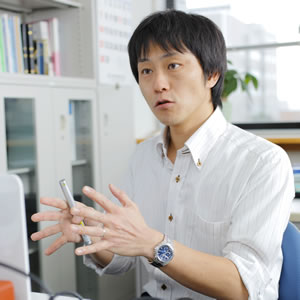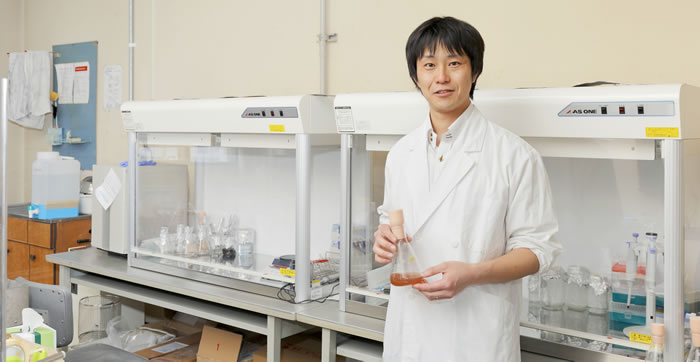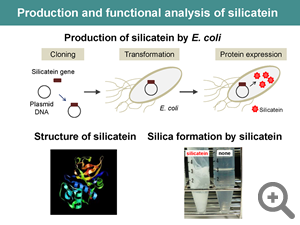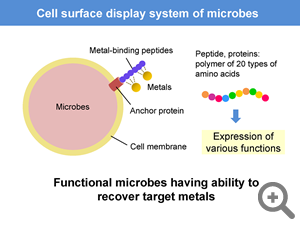- HOME
- Wow! Cool Laboratory [Researcher Introduction]
- Kazunori Nakashima
Wow! Cool Laboratory [Researcher Introduction]

Division of Field Engineering for the Environment,
Research Group of Geoenvironmental Engineering,
Laboratory of Biotechnology for Resources Engineering
Field of research: process/chemical engineering, biofunction/bioprocess
Research themes: biomineralization, biosorption
E-mail: nakashima[a]geo-er.eng.hokudai.ac.jp
Application of excellent biofunctions to geoenvironmental and resources engineering
Focus on the development of technologies that contribute to the recovery and recycling of rare metals
Biomineralization with protein to synthesize minerals
The Laboratory of Biotechnology for Resources Engineering is engaged in the resolution of resource, environmental and energy problems related to our day-to-day lives by leveraging new ideas to utilize and imitate excellent biofunctions from the natural world. Associate Professor Kazunori Nakashima conducts research on biomineralization to produce inorganic minerals using living organisms and biosorption to adsorb metals using microorganisms.
“Seashells, crustacean shells and bones can be cited as examples of biomineralization. These living organisms have a gene intended to create inorganic minerals. The kind of hard tissue and the part of a seashell or human body where hard tissue is located are genetically predetermined. Using the biomineralization function of living organisms, our laboratory is advancing research with the potential to help with civil engineering, construction and environmental improvement.”
Associate Professor Nakashima’s current focus is on biomineralization using protein. This is a technology that uses a sponge protein called silicatein.
“Sponges use silicatein in their bodies to create silica (a component of sand or glass), and thereby form a hard skeleton. I focus on this silicatein, and am thinking about its application to the technology of solidifying substances and material preparation.”
A great amount of silicatein is produced by constructing a plasmid (circular DNA) with a silicatein gene and introducing the DNA into E. coli (Figure 1). Although a variety of enzymes are used in today’s chemical engineering, enzymes must be immobilized on supporting materials for industrial application. It is expected that silicatein can be used for the preparation of the supporting materials such as capsules and gel.
“One of the characteristics of silicatein is that it can polymerize silica at room temperature, atmospheric pressure and neutral pH. Usually, since chemicals such as acids and alkalis are used to prepare silica, enzymes may be deactivated during the procedure. Silicatein, however, can immobilize enzymes under moderate condition.”
It is also expected that silicatein mixed with soil will enable the solidification of soil, which can lead to application in civil engineering and disaster mitigation.
Biosorption to adsorb metals using microorganisms
Biosorption, another of his research themes, is the technology of adsorbing metals and other substances using living organisms.
“Certain living organisms have the ability to adsorb metals, and plants can also adsorb metals. We focus on microorganisms, and use the protein and polysaccharide on the surface of microorganisms to attract metal ions (Note 1). The advantages of microorganisms are that they are environmentally friendly and the preparation procedure is easy. If nourished, microorganisms, which are adsorbent, can naturally grow. Accordingly, they have a considerable advantage in terms of production cost.”
However, since the negative charges of microorganisms and positive charges of metal ions attract each other, it is difficult to adsorb specific metals selectively. Moreover, desorption process of metals adsorbed by microorganisms is usually complicated. To resolve these problems, Associate Professor Nakashima focuses on metal-biding peptides and cell surface display technology (Figure 2), and is working on the development of technology to selectively adsorb metals using the surface of microorganisms.
“It is known that certain types of metal-binding peptides selectively adsorb such metals as gold, platinum and nickel. We are engaged in research to create functional microorganisms that have peptides with high affinity for specific metals through gene recombination, and thereby develop technology to intensively recover target metals using the surface of microorganisms.”
Japan is a country with few natural resources and almost totally dependent on imports for rare metals. However, discarded cell phones contain a great amount of rare metals, and they are referred to as “urban mines.” Associate Professor Nakashima considers that biosorption using microorganisms may enable the recovery of rare metals from these urban mines.
“Although our research still remains at the basic level, the practical application of this technology will make a significant social contribution. Our future themes to work on are the development of metal-binding peptides with a high selectivity and the establishment of cell surface display technology. The use of living organisms helps to minimize environmental load. On the other hand, genetically engineered microorganisms require rigid control. There are many issues to be considered from various perspectives, so we would like to come up with a safer and more stable recovery process.”
| Note 1. | Biosorption using microorganisms Protein and polysaccharide on the surface (cell walls, cell membrane) of microorganisms have minus charges, which attract and adsorb positively charged metal ions. The type of metal adsorbed by microorganisms varies depending on the type of protein. It is considered that the use of this characteristic will make it possible to create microorganisms that adsorb only specific metals. |
|---|

Photo 1. Laboratory


